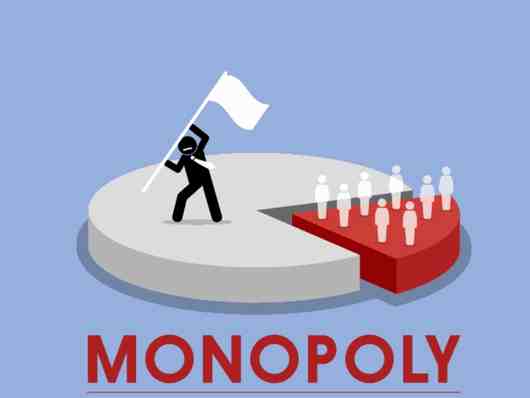One of the factors in the business world is competition. Brands always try to compete to get the most customers and, of course, profit. But what happens when there is no competition, just one sole provider of a product? That is how monopolies work, and it takes more than a paragraph to understand. Monopolies were not created today it can date back in history when it was usually common. You can take a look at examples of monopolies and how it works.
What Are Monopolies
Monopolies are a market with a “lack of competition,” leading to a situation where a specific individual or business is the only supplier of a specific good or service. The term “monopoly” is derived from the Greek words “single, alone” and “to sell.”
Governments, nature, or integration can all result in the formation of monopolies. Monopolies are restricted by laws in many jurisdictions because of possible negative impacts.
Although having a dominant position or a monopoly is not illegal but certain types of behaviour may be considered abusive and subject to punishment when a corporation is dominant.
Contrarily, a government-granted monopoly or legal monopoly is approved by the state, frequently to encourage investment in a hazardous undertaking or to benefit a domestic interest group.
The terms “government-granted monopolies” are frequently used to refer to patents, copyrights, and trademarks. The government may potentially keep the business for itself, creating a monopoly, for instance with a state-owned business.
Because there is no competition and the sector is resource-intensive and expensive to operate, monopolies may develop spontaneously (e.g., certain railroad systems).
What Is a Monopoly in the Business Example?
In the absence of rival businesses, one company could end up being the sole provider of all necessary products or services. A state would have a monopoly on a particular product if there was only one provider operating inside its borders.
Examples of Monopolies
These are the different examples of monopolies.
#1. Microsoft
Microsoft is a company that makes computers and software. It dominates the tech market and effectively monopolizes it with a share of more than 75%.
#2. AT&T
The antitrust rules were broken in 1982 when AT&T, a telecommunications company, was the only provider of telephone services nationwide. The corporation was compelled to divide into six companies known as “Baby Bells” because of its monopolistic practices for service as a necessary telecommunication.
#3. Google
Every time we don’t know the answer to something, we usually turn to Google for assistance. The largest web search engine holds a market share of more than 70% thanks to their proprietary algorithm. Additionally, the business has developed into a web of connected services, including search engines, Gmail, maps, etc. As a result, the business has advanced technologically and innovated more than its rivals Yahoo and Microsoft.
#4. Patents
With the exception of a brief window, patents grant a business a temporary legal monopoly. No other business is allowed to exploit the invention for its purposes while the patent is active. For instance, a casino in Genting Highlands, Malaysia, had a patent that was unique to casinos that were permitted to operate.
For instance, a casino in Malaysia’s Genting Highlands had the sole patent for a permitted casino and had years of legal monopoly in that country.
#5. Railways
Like the railroads, the government offers public services. Since no new partners or privately held enterprises are permitted to operate railways, they have a monopoly. The cost of the tickets, however, is affordable enough for the majority of people to use public transportation.
#6. Facebook
The new market in the twenty-first century is social media. Services are provided without charge to users, yet businesses profit from advertising. Facebook nearly controls this market thanks to its enormous market share. The business is in front of all of its rivals, including Twitter and Google+. Users have increased organically, and social media marketers and other businesses, such as WhatsApp and Oculus Rift, have been acquired. The corporation is so large that it was recently accused of influencing users’ opinions about how elections are contested and swaying them in favour of a particular candidate or political party.
How Monopolies Work
A monopolist can increase a product’s price without being concerned about what rivals will do. If a company increases the price of its products in a completely competitive market, customers will typically switch to other vendors, causing the firm to lose market share.
This straightforward statement is crucial to comprehend the idea of monopoly: The monopolist sets the market price and regulates the quantity of a good or service that is on the market. A monopolist that seeks to maximize its profits, however, is unable to impose any price it chooses.
Think about the following instance: A company ABC has a monopoly for Gym services which is free to set any price it pleases
Company ABC understands, however, that if it demanded $10,000 for each service, nobody would purchase any, and the business would have to close. It is because consumers would swap out gyming for alternative services like in-home training.
As a result, Company ABC will set its price so that it can earn as much as feasible. The monopolist must first identify the features of market demand in order to do this.
Why Monopolies Are Created
Despite the fact that governments often work to prevent monopolies, there are several instances where they actively promote or even instigate them. Government-established monopolies frequently aim to produce economies of scale that benefit customers by lowering costs.
Water, gas, and power utilities are a few examples of organizations built to take advantage of economies of scale. Consider the cost to consumers if, for instance, each of the ten water providers had to dig up neighborhood streets to install their own private water pipes to each home in the community. The same reasoning applies to electrical grids and gas pipelines.
Governments aim to promote innovation in various situations, such as with the laws governing copyrights and patents. A corporation that steals an inventor’s idea and uses it to produce a similar product at a lower price will make all the time, money, and effort invested in writing books, making music, and doing research and development for new treatments to treat disease useless.
What Are Monopolies in History
Monopolies did not begin recently and date back in history when there were recent inventions. The term usually refers to the sole legal right of sale under the government protection and typically secured by a patent or license. The definition of Sir Edward Coke in the seventeenth century is thus “any grant by the King to any person or corporation for the exclusive buying, selling, producing, working, or using anything, whereby any individual or corporate are sought to be restrained of any freedom or liberty that they had before” .
Over time, a monopoly has evolved to be seen as a private amassing of economic power or as an organization that has complete or nearly complete control over a market.
Large corporations that monopolized an industry or a sector in American history were able to set the prices for the products and services they offered.
Many monopolies were seen as beneficial monopolies because they increased efficiency in specific markets without exploiting consumers. Others are viewed as negative monopolies because they restrict legitimate competition while offering little advantage to the market.
What Is the Difference Between Monopolies and Oligopolies?
When there is insufficient competition, market arrangements called monopolies and oligopolies arise. In contrast to an oligopoly, which occurs when a few relatively large enterprises manufacture comparable but slightly different items, a monopoly occurs when a single company provides commodities that have no direct competitors. Both situations have high barriers to entry that keep businesses from competing.
Even though a few comparable businesses exist in other parts of the country, one company may dominate an industry in a certain region where there are no rivals. In this scenario, a business can have monopoly status in one area but operate in an oligopoly market across a larger geographic area. Market conditions in the economy include oligopoly and monopoly.
The primary distinction between oligopoly and monopoly is that the former occurs when one business provides items without any similar or close substitutes on the market, whereas the latter occurs when a number of very large enterprises manufacture identical things with minor variations.
Examples of monopolies that can occur are electricity, railroads, water and FMCG automobiles are examples of an oligopolies.
Is Walmart a Monopoly?
Walmart has the traits of a monopoly due to its size in comparison to its rivals. The company operate about 8500 outlets.
Neither Walmart is a monopoly nor is it “nearly a monopoly.” Despite regional variations, Walmart faces fierce competition in its industry. Therefore, Walmart is still not regarded as a monopoly as of 2023, although having numerous characteristics of one as a result of its domination in the retail sector. For instance, businesses like Costco, Amazon, and Target that sell comparable goods can still compete with Walmart.
Is McDonald’s an Example of a Monopoly?
A frequent illustration of monopolistic competition is McDonald’s. Monopolistic competition is a sign of the variety of goods on the market. Although having comparable items, they still differ from one another in a number of ways. McDonald’s has several locations and dine-ins in addition to dividing its items into various types. KFC, Subway, Burger King, and other comparable businesses compete with it. Although they are all part of the same type of restaurant chain and offer fast meals, their very foundations differ.
As a result, the entity becomes both the price setter and the sole seller in the market. By choosing the product’s selling price and the amount of the equivalent, they can optimize their profit. In addition, McDonald’s uses a practice known as “pricing discrimination,” in which it charges various customers varying prices for the same product in an effort to maximize profits.
What Is a Monopoly and Why Is it Bad?
Monopolies are undesirable because they have no competitors because they monopolize the market in which they operate. When a business has no rivals, customers are forced to do business with a monopoly. There is no restriction on the company’s ability to increase prices or decrease the calibre of its goods or services.
Monopolies inhibit innovation as well. There is little motivation to develop new processes for producing superior goods.
What Does Monopoly Mean and What Example?
A monopoly is a market arrangement in which there is just one vendor and they have an exclusive product to sell. As the only vendor of the goods with no viable alternatives, the seller in a monopoly market has no rivals.
In a monopoly market, an entity becomes the sole seller of commodities due to reasons such as government licensing, resource ownership, copyright, and patent protection, as well as high startup costs. These characteristics collectively prevent other sellers from entering the market. Monopolies also have access to information that other merchants do not.
What Are 2 Companies That Are Monopolies?
#1. Luxottica
The owner of all the main sunglasses brands is Luxottica. The business has acquired practically all of the main eyewear manufacturers. They still have different names, though. Although they are all made by the same business, it gives the impression to the buyer that they have a selection of sunglasses to pick from. Luxottica produces and sells more than 80% of the eyeglasses worldwide.
#2. InBev
InBev is the parent company of AB InBev\sAB Budweiser, Corona, Beck’s, and other brands. It was a business created by the union of Anheuser-Busch and InBev. These beers all come from the same manufacturer, despite having various names and compositions that result in various tastes. Hence, in a way, consumers of many Beers are paying a single business.
In Conclusion,
Monopolies are companies that are the sole providers of a particular product. Moreover, monopolies are frequently found in sectors with high beginning costs, which makes it even harder for potential rivals to capture any market share.
FAQs
Do monopolies occur naturally?
Natural monopolies can form in some industries. An industry with high beginning costs or inherent entry hurdles may result in a dominant corporation controlling the market. Also, businesses that obtain a patent for their product may be the only ones with authority by law to manufacture a specific product for a specific amount of time.
What are the charecteritcs of a monopoly
- Due to a lack of competition, monopolies can set any price they wish for their products. Monopolies have the right to charge whatever price they choose, making them the price setters as there is no competition to drive down rates to draw customers.
- Normally, business methods are determined by supply and demand. In a monopolistic market, the company has control over both supply and demand. No matter how much demand there is, they have the option of cutting back on supply.
- Access to critical information is restricted, which presents another barrier to entry in a monopoly market. Owners of monopoly markets frequently have access to information that rivals do not, making it challenging for others to enter the market.
What are the causes of monopoly
- Exclusive production rights: On occasion, the government may give a business the authority to create a manufactured monopoly by granting it the sole right to produce a good or service.
- Returns on investment: A large, established business can be able to manufacture more goods at a lower cost, hence boosting its returns on investment.
- Low demand: Competitors may be reluctant to enter the market if a company provides a good or service that isn’t in high demand since they don’t see an opportunity to make money.
- Resource control refers to the ability of one corporation to limit the delivery of a resource that is crucial to their industry to other businesses.
Related Articles
- Oligopoly: Definition with Examples & All You Should Know
- WHAT IS NON-PRICE COMPETITION? Best Strategies, Examples, Pros & Cons
- HOW TO SELL ON WALMART: All You Need to Know
- Walmart Hours for 2022 Black Friday
- Why Nokia failed and 4 ways to protect your business






